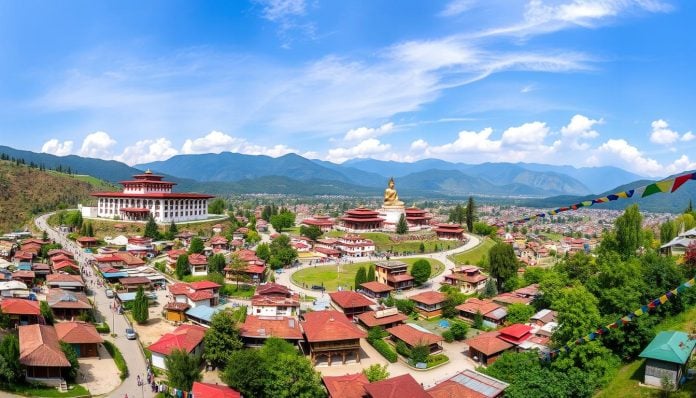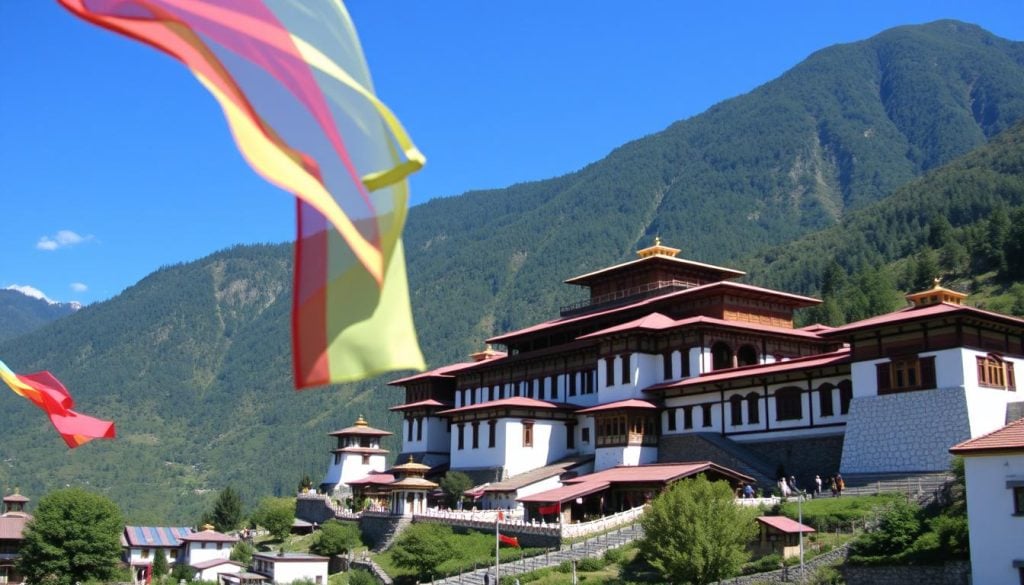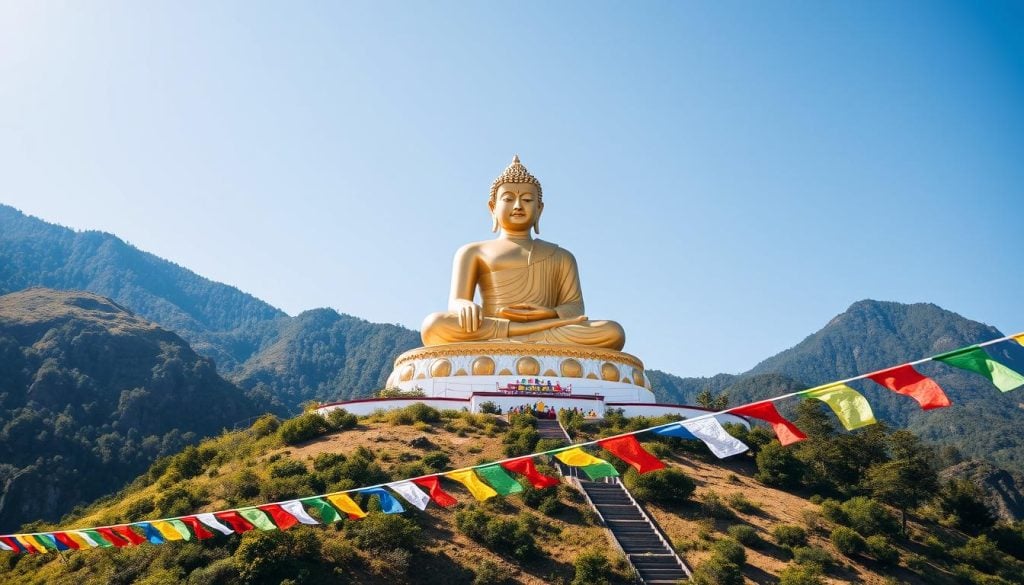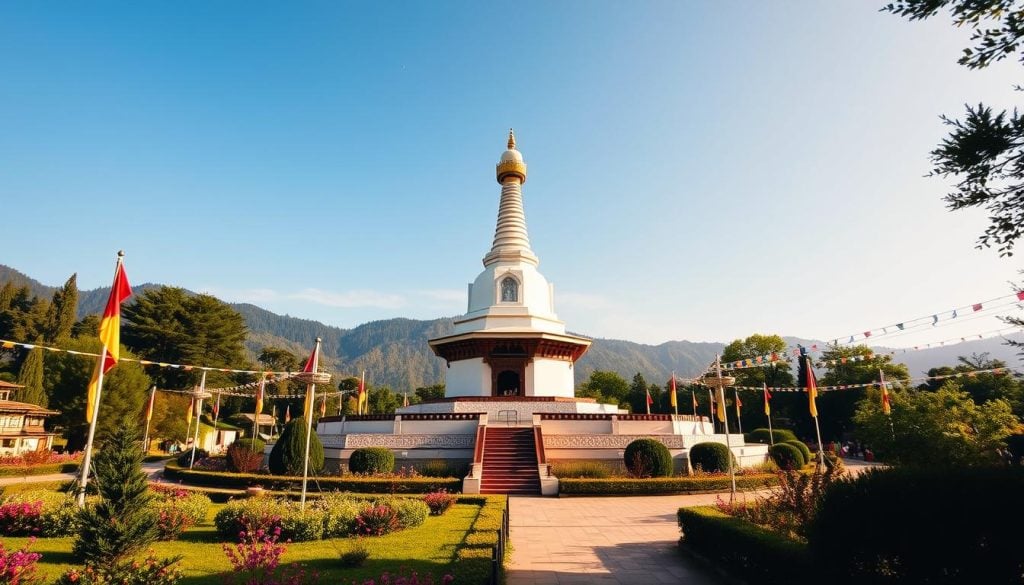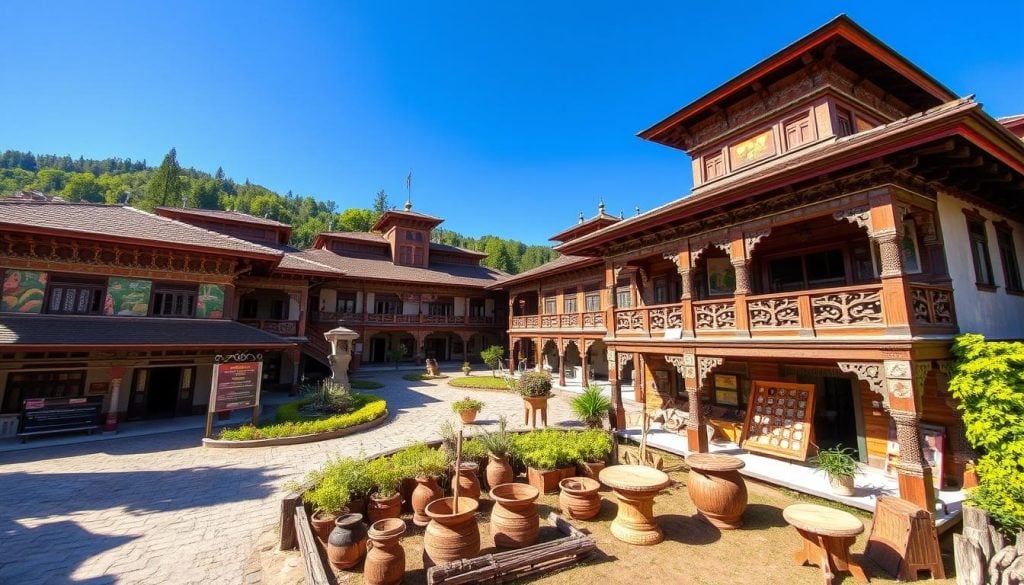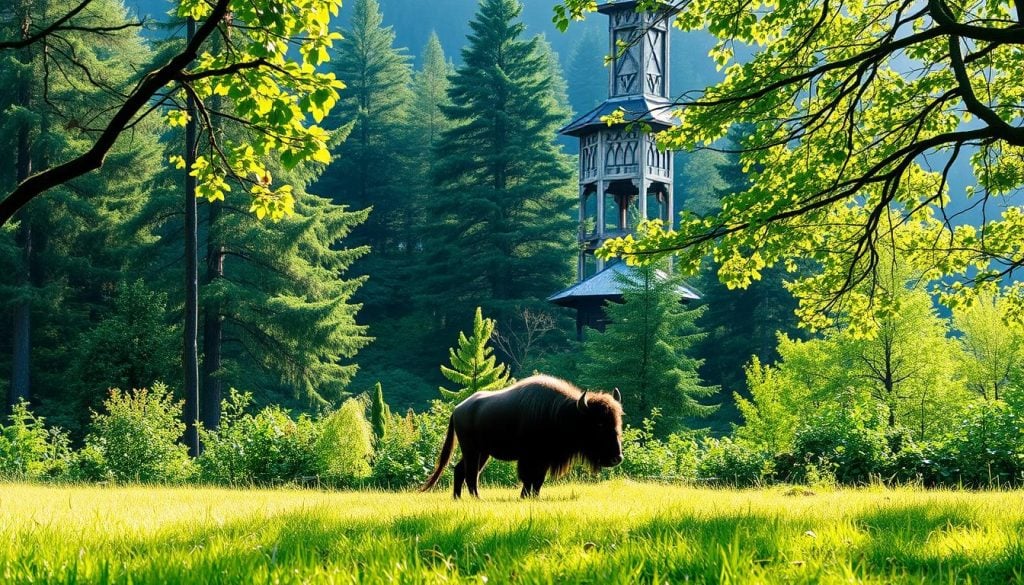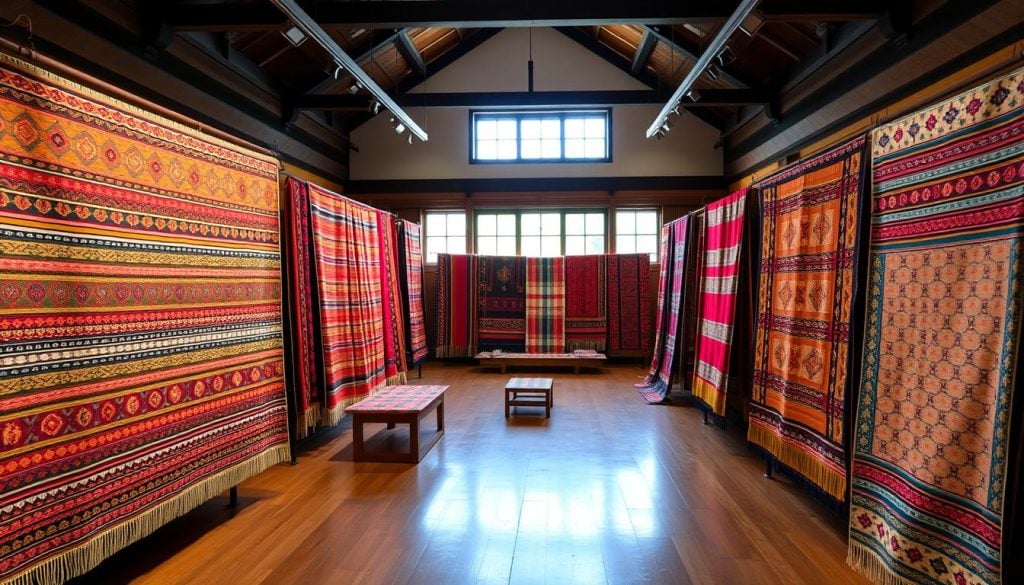Ever wonder why Thimphu, the capital of Bhutan, is such a secret treasure? It sits quietly in the Himalayas. As you explore the Top 10 Things to Do in Thimphu, you’ll see stunning scenes and rich traditions. Picture majestic spiritual sites and busy markets blending the old with the new. Every place has its own tale, making *Thimphu sightseeing* unforgettable.
This guide will show you the best sights and activities in Thimphu. Get ready for the serene beauty and lively culture in this magical city. Your trip will be packed with moments you’ll always remember.
Discover Tashichho Dzong: The Heart of Bhutan’s Government
Tashichho Dzong is vital for anyone exploring Thimphu. It’s near the city center, just 2 km away. The structure showcases Bhutan’s history and serves as the administration center. It also displays the country’s heritage and architectural beauty.
Significance of Tashichho Dzong in Thimphu
Tashichho Dzong has been Bhutan’s government hub since 1952. It dates back to 1261 and underwent major rebuilds in 1771 and 1897. The dzong is both a government office and a monastery. It highlights the blend of political and religious practices in Bhutan. Every year in late September, it hosts the Thimphu Tshechu festival. This event is a colorful exhibition of Bhutanese culture, attracting many visitors. The festival and the peaceful atmosphere underline its status as a key attraction.
Architectural Highlights and Features
The architecture of Tashichho Dzong is stunning. Look for its golden roofs and white walls which showcase Bhutanese art. Inside, the Golden Buddha Hall holds a remarkable 6-foot Buddha Shakyamuni statue. The surrounding gardens and views are also worth noting. These gardens are especially beautiful with peach blossoms in spring. In autumn, the clear skies offer unforgettable views.
Visiting Schedule and Guidelines
To see Tashichho Dzong, here’s when to go:
| Day | Hours | Entry Fee (BTN) |
|---|---|---|
| Monday – Friday | 5:00 PM – 6:00 PM | 500 |
| Saturday – Sunday | 9:00 AM – 5:00 PM | 500 |
Dress modestly for your visit, which should take 1-2 hours. Nearby, places like the Royal Textile Academy and Choki Traditional Art School add to the experience. They further enrich your journey into Bhutan’s culture.
Visit the Majestic Buddha Dordenma: A Giant Statue of Serenity
The Buddha Dordenma is a beacon of calm and deep spiritual meaning in Bhutan. Standing tall at 51.5 meters, it overlooks Thimphu valley, attracting those looking for Thimphu attractions. It’s not just a great engineering work but also a place for deep reflection and peace.
Overview of Buddha Dordenma’s Features
The Buddha Dordenma, built from 2006 to 2015, is made of bronze and covered in gold. Below it, there’s a huge chamber holding 125,000 smaller Buddha statues. Each one carries its own lessons and blessings. Its size places it among the world’s largest Buddha statues, marking it a top sight in Thimphu.
Activities at the Buddha Dordenma Site
Surrounded by beautiful gardens, the Buddha Dordenma site is perfect for quiet thought or enjoying nature. Visitors can:
- Light butter lamps as a sign of devotion
- Enjoy sweeping views of Thimphu
- Join in on traditional rituals and meditation
- Walk around the gorgeous Kuensel Phodrang Nature Park
Entry is free, and taking pictures is welcomed in most spots, except the meditation areas. To fully enjoy the site, visit in the early morning or late evening. That’s when the light perfectly highlights the statue.
Unwind at the National Memorial Chorten: A Spiritual Landmark
The National Memorial Chorten is a symbol of Bhutanese culture in Thimphu. It honors the third King, Jigme Dorji Wangchuck, since 1974. Its unique shape and gold finials welcome all for reflection. This chorten reflects Bhutanese beliefs and traditions in its essence.
Importance of the Chorten in Bhutanese Culture
The Chorten has deep spiritual meaning in Bhutan. It’s where people pray and meditate together. This place reminds everyone of the value of peace and compassion in Bhutan.
Being a major attraction in Thimphu, it draws many wanting to know its history and its daily role in life.
Experiencing Daily Pilgrimages and Rituals
A visit lets you see daily spiritual practices. People walk around it clockwise, a process called circumambulation. They also recite prayers and spin prayer wheels.
The area is lively with colorful prayer flags and chanting. This experience not only shows you Bhutanese culture, it also brings peace.
Top 10 Things to Do in Thimphu: Explore the Weekend Market
The weekend market in Thimphu is full of life and culture. From Thursday to late Sunday, it’s the perfect place to see Bhutanese life up close. You’ll find fresh produce, handmade textiles, and unique crafts. The market is lively, with vendors showing off their goods.
What to Expect at the Weekend Market
When you arrive at the weekend market, you’ll see many products that show Bhutan’s culture. There are:
- Fresh fruits and vegetables
- Handmade textiles and clothing
- Traditional crafts and souvenirs
- Spices and herbs unique to the region
The market is more than a place for tourists. It’s where locals come together, mixing community and trade.
Local Delicacies and Unique Souvenirs
At the Thimphu market, you can find amazing local food. Try Ema Datshi, a spicy chili cheese dish. You can also try:
- Wild honey
- Dried fish
- Homemade cheese
Look for special souvenirs while you’re there. You can find handicrafts, traditional incense, and more. It’s a key part of the Thimphu experience.
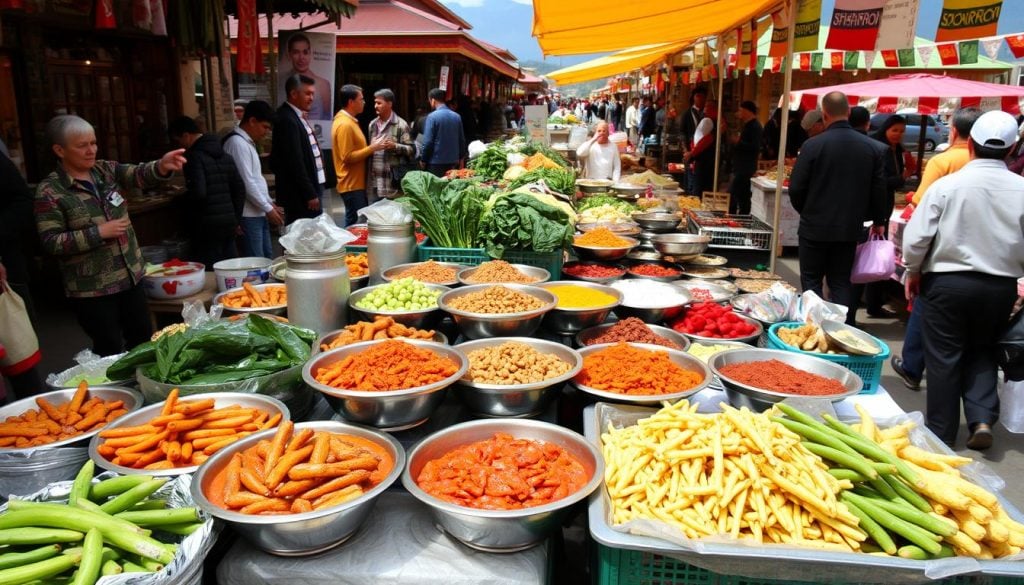
Immerse Yourself in the Folk Heritage Museum: A Glimpse of Bhutanese Life
The Folk Heritage Museum lets you see traditional Bhutanese life up close. It is in a farmhouse over 150 years old and shows you rural family life. It has items and crafts that are key to Bhutan’s culture.
You will see customs and practices of daily living here. This museum in Thimphu is essential for anyone wanting to really understand Bhutan.
Exhibits Showcasing Traditional Bhutanese Culture
The museum has a rich collection of artifacts. These items share the story of life in Bhutan. Highlights include:
- Traditional Household Items: Discover tools and utensils used in rural households.
- Craftsmanship: View textiles, pottery, and woodwork representative of Bhutan’s rich artisanal culture.
- Rural Living Displays: Explore the setup of traditional homes, showcasing how families lived a century ago.
Interactive Activities and Demonstrations
The museum offers many hands-on activities about Bhutanese culture:
- Cooking Classes: Participate in a traditional cooking class for two hours to learn dishes like Ema Datshi and Momos.
- Textile Weaving Demonstrations: Gain insights into Bhutanese weaving during a one-hour demonstration.
- Archery Experience: Try traditional Bhutanese archery for an hour with genuine equipment.
- Heritage Garden Walk: Enjoy a 30-minute walk to learn about organic farming and native plants.
- Folk Dance Performances: Watch traditional Bhutanese dances live, showcasing local art.
Going to the Folk Heritage Museum is a must in Thimphu. It’s perfect for those who wish to dive deeper into the Bhutanese way of life. It offers interactive fun that highlights Bhutan’s rich cultural background.
Explore Trashi Chho Dzong: A Historic Fortress
Trashi Chho Dzong is a beautiful example of Bhutan’s architecture and culture. It sits at Thimphu’s northern end. This fortress is very important for Bhutan’s government and spiritual life. It was first built in the 12th century and has seen many changes since then. These changes highlight important parts of Bhutan’s past. With its grand structure and lovely courtyards, it’s a key spot to see in Thimphu.
Historical Significance of Trashi Chho Dzong
The fort first went up in 1216, known then as Dho-Ngen Dzong. In 1641, it got a new name: Trashi Chho Dzong, thanks to Zhabdrung Ngawang Namgyal. It faced destruction by fire twice, in 1771 and again in 1866. But, King Jigme Dorji Wangchuck started rebuilding it in 1962. Now, it’s Bhutan’s administrative center. It houses the king’s offices, various ministries, and sacred places.
Recommended Visiting Hours and Etiquette
Trashi Chho Dzong is open for visitors from early morning to late afternoon. It’s good to wear respectful clothes, especially in holy areas. Make sure to check out the courtyard. It’s where traditional dances are performed during the annual tsechu festival. This festival is a bright window into Bhutanese tradition. Enjoy the dzong’s peaceful feel but remember to be considerate.
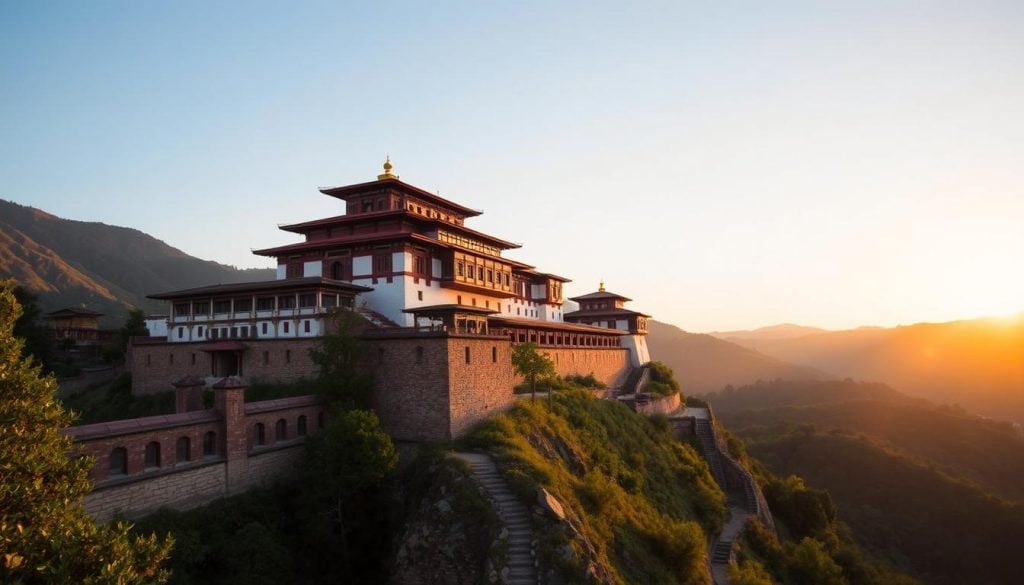
Experience Nature at Motithang Takin Preserve: Meet the National Animal
The Motithang Takin Preserve is in peaceful Thimphu. It lets visitors meet Bhutan’s national animal. What was once a zoo now shows how the takin is important in Bhutanese culture and myth.
The Unique Takin and Its Cultural Importance
The takin looks like a mix of a goat and a cow. It’s special in Bhutan’s stories. They say a Lama made the takin using magic, combining a goat. Seeing this creature is special. It makes visiting Thimphu even better.
Visiting the Preserve: What to See and Do
Explore the Motithang Takin Preserve on beautiful trails. You’ll see bright plants and animals. Here’s what to expect:
- Walking trails through green areas.
- Places to watch takins just being themselves.
- Displays that talk about takins in Bhutan’s culture.
- Chances to take photos of Bhutan’s wildlife.
Remember to watch wildlife the right way to respect the animals and other people. It’s close to the city, so don’t miss the Motithang Takin Preserve when in Thimphu.
Experience Traditional Weaving at the National Textile Museum
The National Textile Museum is a must-visit for those fascinated by Bhutanese textiles. It was opened in 2001, with Her Majesty Queen Ashi Sangay Choden Wangchuk’s support. This museum is special because it shows the deep history and importance of weaving. You can see clothes worn by the Royal Family, which lets you see how Bhutanese craft has evolved.
What to Learn about Bhutanese Textile Traditions
At the museum, you learn about the detailed art of Bhutanese textiles. The exhibits cover both old and new weaving methods. They show how important textiles are in both ceremonies and daily life. You’ll find that each piece has its own story, showing Bhutanese history and beliefs.
Exhibitions and Activities for Visitors
The museum offers lots of interesting things for visitors. You can join workshops and see weaving up close. It’s open from 9 AM to 5 PM, Monday to Saturday, and 10 AM to 3 PM on Sundays. For a 250Nu fee, you get into this wonderful place. It’s among the top activities in Thimphu.
There’s more than just the main displays at the museum. It also has special events, including online shows for when you can’t visit in person. Places like the National Folk Heritage Museum and the Craft Gallery by Queen Mother Sangay Choden Wangchuck make your visit even better.
| Feature | Details |
|---|---|
| Established | 2001 |
| Entry Fee | 250Nu |
| Opening Hours | 9 AM – 5 PM (Mon-Sat), 10 AM – 3 PM (Sun) |
| Nearby Attractions | National Folk Heritage Museum, Jigme Dorji National Park, Choki Traditional Art School |
| Investment | $160K |
Conclusion
Thimphu, Bhutan’s capital, is a fascinating mix of culture, history, and natural beauty. Explore top sights like Tashichho Dzong and the National Memorial Chorten. These attractions show you Bhutanese life. This guide invites you to dive into local traditions and enjoy Thimphu’s peace.
Seeing the majestic Buddha Dordenma and visiting the Centenary Farmers Market are special. You’ll understand what makes Thimphu unique. There’s something for everyone here, promising unforgettable experiences and new insights.
Your trip to Thimphu is more than just visiting places; it’s about connecting with Bhutan’s heritage and people. Use this guide to explore the stunning landscapes and cultural richness of this amazing city.

































